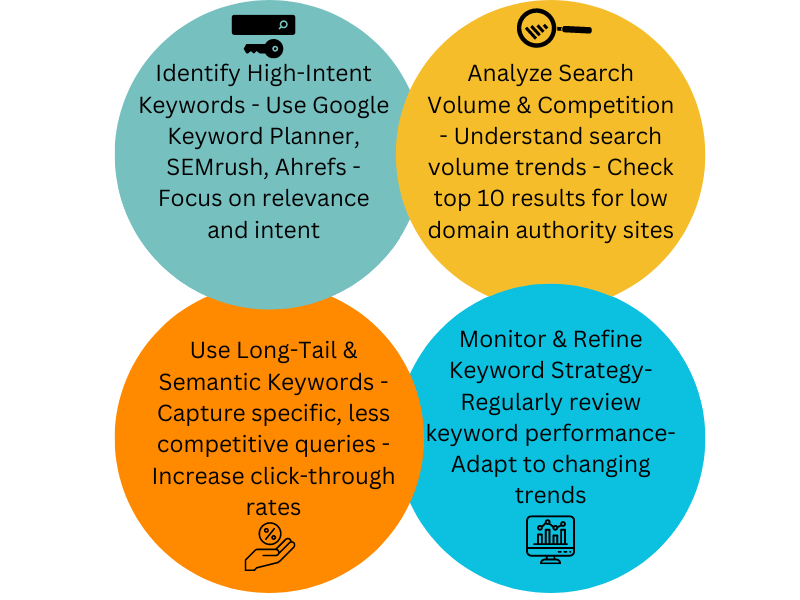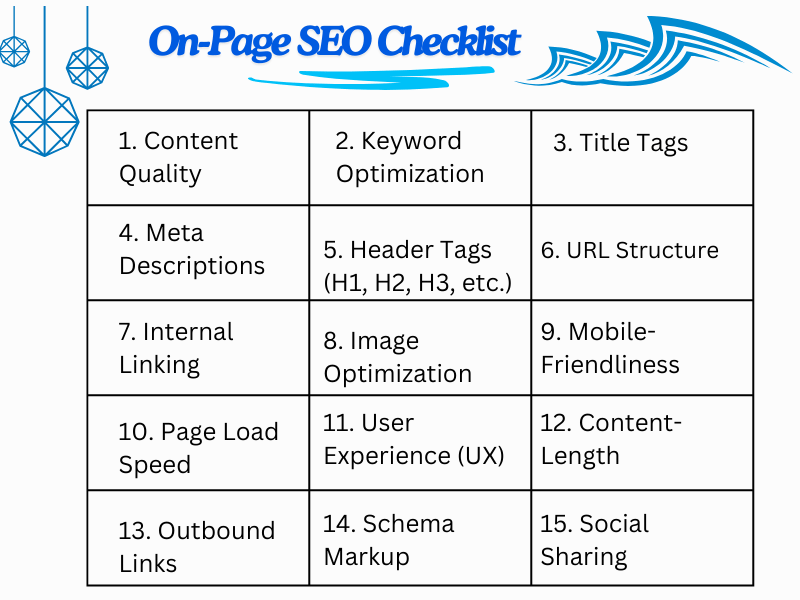Introduction to Keyword Targeting
The key to an effective SEO strategy is keyword targeting. In order to increase your chances of being found in search results, you must identify the right keywords and phrases that potential customers are looking for. Therefore, you’ll have to align your content with these keywords as well as work on optimizing your website. This means that we will discuss about key aspects of keyword targeting and on-page SEO which will help one take over search engines.
A Visual Guide to Keyword Targeting
For an SEO campaign to succeed, it must first have effective keyword research as its foundation in the SEO Audit Checklist. With enhanced keyword research software packages as well as investigations of rivals and people’s motivations, it is easy to find out valuable keywords for every enterprise. The main points to consider when looking for keywords are:

- Identifying Relevant and High-Intent Keywords: Utilize a combination of keyword research tools, such as Google Keyword Planner, SEMrush, and Ahrefs, to identify the most relevant and high-intent keywords for your business. Also target the keywords intent according to your websites goals choose from informational, commercial and traditional keywords.
- Understand search volume and competition for target keywords: Prioritize promising options got a new website? Check top 10 results for low domain authority websites ranking. If none, skip that keyword. Choose keywords with existing low DA rankers.
- Incorporating Long-Tail and Semantic Keywords: Choose long-tail and semantically related keywords to capture more specific and often less competitive search queries. These type of keyword are very straight forward and have high click through rates because they demand direct answers.
- Continuously Monitoring and Refining Your Keyword Strategy: Regularly review and update your keyword strategy to adapt to changing search trends and user behavior.
Optimizing Your Website’s Structure
The structure of your website plays a crucial role in on-page SEO. By ensuring your website has a logical, intuitive, and easily crawlable architecture, you can guide both users and search engines effortlessly through your content. We’ll explore the following key aspects of website structure optimization:
- Developing a Clear Information Architecture: Organize your website’s content into a clear and logical hierarchy, making it easy for users and search engines to navigate and understand.
- Implementing Keyword-Rich URLs: Utilize clean, keyword-rich URLs that accurately reflect the content and services on each page. This makes it easier for search engines to understand the relevance of your pages and index faster.
- Ensuring Seamless Indexation and Crawlability: Optimize your website for efficient indexation and crawlability, enabling search engines to discover and index your content with ease. After posting every blog or article go to Google Search Console and index that specific page manually.
- Enhancing Internal Linking: Improve user experience and content discoverability by implementing a well-structured internal linking strategy that guides users and search engines through your website. You can do this by internal linking other similar previously written articles/blogs to your main article.
Creating Converting and Optimized Content
Content is the lifeblood of any successful SEO strategy. By creating high-quality, informative, and engaging content, you can attract and retain your target audience while also signaling to search engines the relevance and authority of your website. We’ll explore the following content optimization strategies:
- Incorporating Target Keywords: Strategically incorporate your target keywords throughout your content, including in the title, headings, meta tags, and body text, alt tags, to ensure search engines can easily understand the topic and relevance of your pages.
- Optimizing Meta Tags: Create eye catching and keyword-rich meta titles and descriptions to improve your click-through rates and search engine visibility.
- Alt Text and Image Optimization for SEO: Optimize your images with relevant alt text and file names to make your content more accessible and improve your search engine rankings.
- Ensuring Content Readability and Engagement: Create content that is easy to read and engaging for your target audience, using clear language, short paragraphs less than 20 words and relevant visuals to keep readers interested and on your site. Use active and passive voice clearly along with transition words.

Measuring and Analyzing SEO Performance
Effective SEO is an ongoing process that requires continuous monitoring, analysis, and optimization. In our blog “A Visual Guide to Keyword Targeting and On-Page SEO“, we’ll explore the key metrics and tools you can use to track the success of your SEO efforts and make data-driven decisions:
- Measuring with Google Analytics: Utilize the powerful insights provided by Google Analytics to understand your website’s traffic, user behavior, and conversion rates.
- The Power of Search Console: Use Google Search Console to monitor your website’s indexation, search performance, and identify any technical issues that may be impacting your rankings.
- Tracking Keyword Rankings: Monitor the rankings and performance of your target keywords to measure the effectiveness of your SEO strategy and make necessary adjustments.
- Conducting Competitor Analysis: Regularly analyze your competitors’ SEO strategies, content, and link profiles to identify opportunities for improvement and stay ahead of the curve.
- Establishing Comprehensive Reporting: Create a robust reporting system to track your SEO progress, identify areas for improvement, and continuously optimize your strategies for maximum impact.
Conclusion: Mastering Keyword Targeting and On-Page SEO
While On-Page SEO is important, keep in mind that technical SEO and Off-Page SEO should not be compromised. By mastering the strategies and techniques outlined in “A Visual Guide to Keyword Targeting and On-Page SEO“, you can position your website as a dominant force in your industry’s search engine rankings. From optimizing your websites structure and content to conducting thorough keyword research, every element plays a crucial role in Keyword targeting and On-Page SEO.
